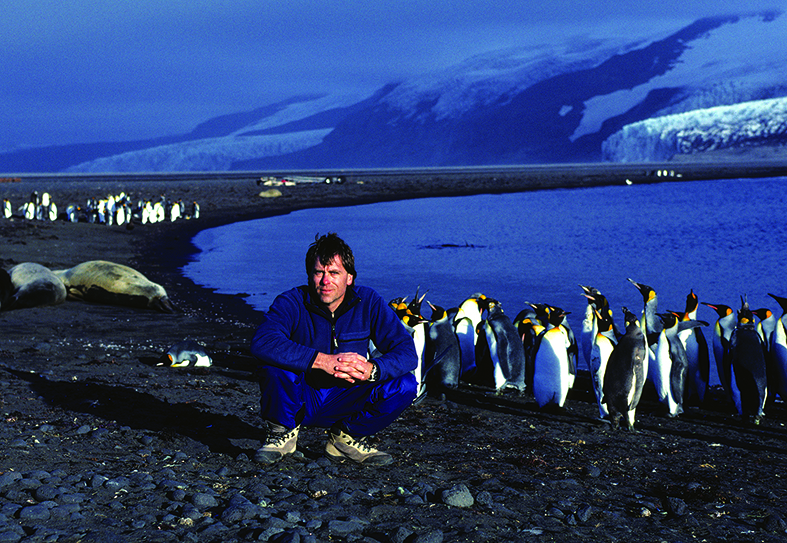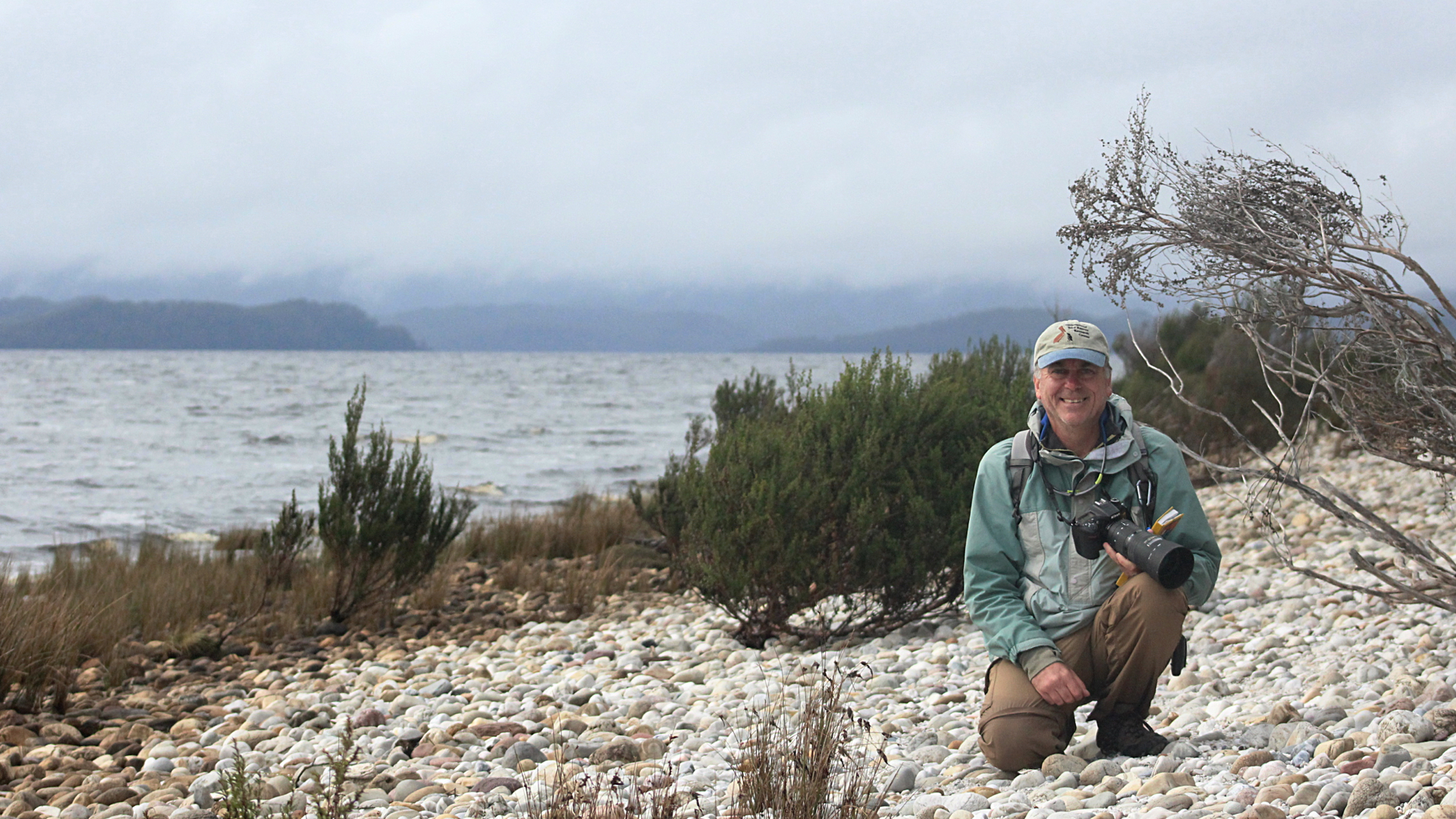Learning he had been nominated in this year’s Queen’s Birthday Honours Awards came as a complete surprise for BirdLife Tasmania convenor Eric Woehler. Although humbled and honoured to know his advocacy work over the last 40 years on behalf of birds had not gone unnoticed, the identity of the person who nominated him remains a mystery.
“I think the award legitimises the efforts that we’ve made over the last 40 years. Fundamentally the award is a recognition of contributions made by so many Australians to their communities and to society, and these awards show we’re a nation of volunteers.”
Born to parents who met and married in Tasmania after arriving separately as refugees after World War Two, Woehler grew up in Hobart where he undertook his undergraduate degree in zoology at the University of Tasmania. The lightbulb moment that set him firmly on the bird ecologist career path came while he was a UTAS undergraduate in the late 1970s. He attended a lunchtime seminar with lecturer and marine biologist Eric Guiler, who was later also renowned for his work on the thylacine and the Tasmanian devil. It was while listening to Guiler talk about his conservation research and survey work on marine animal and bird species that Woehler realised this was an area of work he also wanted to do.
“Guiler had been to Macquarie Island the previous summer as part of an advisory committee that looked at the research there and he gave a lunchtime talk about his trip. I talked with him afterwards, and later that year as part of my Honours program, I got the opportunity to go to Macquarie Island and study royal penguins. That trip was followed by some other surveys and field trips and then two years later I was on the Nella Dan – the vessel then used in Australia’s Antarctic program – for my first trip to Antarctica.”

An opportunity to study for his PhD in the US came during an Antarctic conference that was held in Hobart in 1988. Woehler was invited by one of the US researchers to apply for a place in the scholarship program being offered by the University of California. His application was successful so from 1990 to 1995 Woehler was based in the US combining research on populations of Leach’s storm petrels in the Aleutians as part of his PhD studies, with teaching commitments at the university.
Back home in Tasmania Woehler’s research and survey work has subsequently allowed him to travel the globe monitoring and recording vulnerable and threatened marine animal and bird species. Although conducted with less media attention and fanfare than the work of well-known naturalist and TV presenter David Attenborough, whose early documentaries first sparked Woehler’s interest during the early ‘70s, the data collected from those surveys has proved invaluable in providing a greater understanding of seabirds and marine ecology more broadly.
The quantitative data collected over so many long-term surveys and studies has shown the ecological changes in species’ distribution and populations sizes. The rise in extinctions, population decreases, emerging wildlife diseases, and the detrimental health impacts from pollution, industry emissions, waste, and human activity have all resulted in a greater focus on Woehler’s research and long-term studies, particularly on birds. The latest challenges involve a push to create marine parks, the protection of the high seas and the potential to create high seas’ reserves to protect their habitats for threatened and endangered species.
In addition to a growing public awareness of the environmental risks associated with climate change, and the negative impacts these are increasingly having on wildlife species, the data also provides the evidence needed by governments to better identify and establish conservation and management practices.
“At the moment we have a number of marine parks around Australia within our exclusive economic zone (EEZ). For many of these parks we literally have no idea how many birds or mammals have been recorded. For four years pre-COVID we did a lot of work on seabird and marine mammal surveys from a research vessel documenting different species inside those marine reserves.
“We’re now in a position to generate and seek funding for the first time so
we can provide governments with quantitative data that can define what might be a hotspot, or a barren region or whatever. These data are then available for state and federal government agencies to use, and to provide guidance when developing management and conservation policies that are based on science. You can make sweeping generalisations but to have any hope of getting a sense of a genuine trend you need quantitative data, and be able to back it up with good analyses.”
The ongoing field research projects on shorebirds and seabirds, that has allowed Woehler the opportunity to travel and work in all seven continents, has been combined with a position as adjunct with UTAS, teaching undergraduate students and supervising higher-degree research students in a voluntary capacity. This position is one he has held since his return from the US in 1995. The focus of his research projects has always been directed towards conservation and the adoption of best-practice management practices, to help create a greater understanding among the general public that birds have a crucial ecological and biodiversity role in maintaining healthy environments wherever they are found in the world.
“Because birds are at the top of their food chain in pretty much every habitat in which they live – woodland, wetland, or at sea – they provide a very good indicator about the health of the environment. So many species around the planet are now threatened with extinction, giving very clear signals all is not well with planet Earth. That’s a shocking indictment on our use of land and oceans, and on their management and its impact on wildlife.”
While Woehler’s field trips have involved research in exotic Arctic, sub-Antarctic, Antarctic, and North American locations and have allowed him to travel to within 1000 km of both the North and South Poles, he has also led the conservation effort closer to home highlighting the risks for Tasmania’s birds. Some species such as swift parrots, masked owls and orange-bellied parrots are decreasing and genuinely threatened with extinction, and he spends much of his time trying to educate and engage the public, not just about the risks from the state’s forestry and mining practices, but also the risks to farmers and agriculture from loss of biodiversity and the important pollination role birds have for many of our crops.
“At the moment we have approximately 10,000 species of birds, globally. About 1500 of these are formerly listed by the IUCN’s Red List as having a threatened status of some sort; vulnerable, endangered, critically endangered or whatever. We rely on birds for so much, including pollination of crops. Birds have a role, as do insects, and birds also do a good job in managing insects, so we really are fouling our own nest in so many ways. Yet it’s clear from our BirdLife Tasmania community events that everyone has an awareness or an interest in birds and can relate a story about a magpie, a parrot or an eagle on their property, so birds are valued by people.”
Despite observing and researching thousands of birds in his career, Woehler has never kept a tally of the number of species he has monitored and claims he has no favourites. He said it all depended on where he was at the time, and what might be happening as he walks along Tasmania’s beaches, but he admits to being, ‘very tuned into’ fairy terns, a species he has studied for many years, and which is now showing somewhere in the region of a 90 per cent decrease across Australia as a whole.
“At sea I take pure delight in watching albatrosses cruise over the ocean surface, but it’s been a challenge to note the fundamental shifts in the reduction of species like the blue petrel where huge flocks were sighted in the Southern Ocean during the ‘80s and ‘90s, but where I didn’t see a single bird during the last couple of trips.
“Tasmania is recognised as a bellwether for the flyway used by migratory birds, a predictor where we first pick up the signals that indicate change. A lot of my work has been on long-term population studies, on population trends of shorebirds and migratory birds and the message is clear and unambiguous and it’s all going in the wrong direction. Due to variations in state and national legislations swift parrots, for example, have gone from being listed as threatened, to endangered under Tasmanian legislation yet are considered critically endangered under the EPBC. There is no ‘critically endangered’ status under Tasmanian legislation so masked owls are listed as endangered, but are considered vulnerable under the EPBC, and these changes have occurred in a relatively short period of time. In Tasmania we’re seeing something in the order of a 95 per cent decrease in eastern curlews who migrate to Tasmania’s coasts and wetlands. This loss of biodiversity will, I think, cost Australia dearly and result in a deterioration of our quality of life.”
Despite all the challenges Woehler remains optimistic and has no regrets that the advocacy work he has done on behalf of birds and the environment has resulted in limited employment opportunities with some government agencies.
“I’ve no regrets and would do the whole thing all over again. We need people to stand up because we’re losing so much and it’s not right for future generations to be denied the opportunities to have what we’ve taken for granted, so I’ll keep doing what I’m doing because I don’t know when to stop! I reckon I’ve got another 20 years in me. The alternative is sitting on a couch watching TV and channel surfing, and that’s not going to achieve anything.”
Anne Layton-Bennett





